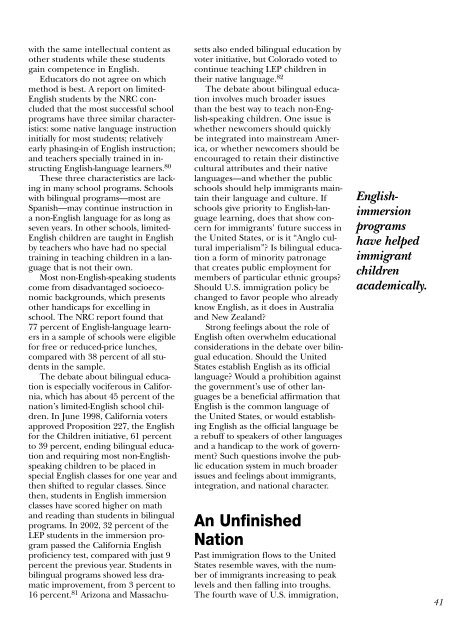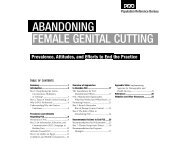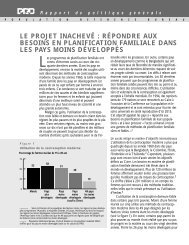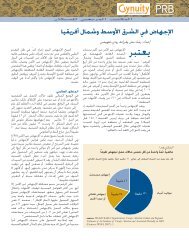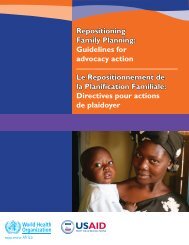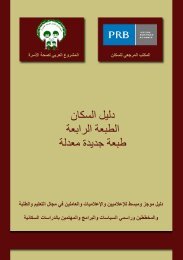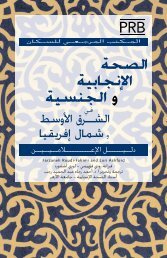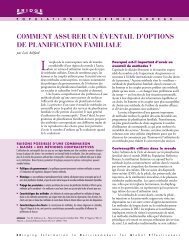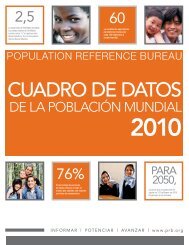Immigration Shaping America - Population Reference Bureau
Immigration Shaping America - Population Reference Bureau
Immigration Shaping America - Population Reference Bureau
You also want an ePaper? Increase the reach of your titles
YUMPU automatically turns print PDFs into web optimized ePapers that Google loves.
with the same intellectual content as<br />
other students while these students<br />
gain competence in English.<br />
Educators do not agree on which<br />
method is best. A report on limited-<br />
English students by the NRC concluded<br />
that the most successful school<br />
programs have three similar characteristics:<br />
some native language instruction<br />
initially for most students; relatively<br />
early phasing-in of English instruction;<br />
and teachers specially trained in instructing<br />
English-language learners. 80<br />
These three characteristics are lacking<br />
in many school programs. Schools<br />
with bilingual programs—most are<br />
Spanish—may continue instruction in<br />
a non-English language for as long as<br />
seven years. In other schools, limited-<br />
English children are taught in English<br />
by teachers who have had no special<br />
training in teaching children in a language<br />
that is not their own.<br />
Most non-English-speaking students<br />
come from disadvantaged socioeconomic<br />
backgrounds, which presents<br />
other handicaps for excelling in<br />
school. The NRC report found that<br />
77 percent of English-language learners<br />
in a sample of schools were eligible<br />
for free or reduced-price lunches,<br />
compared with 38 percent of all students<br />
in the sample.<br />
The debate about bilingual education<br />
is especially vociferous in California,<br />
which has about 45 percent of the<br />
nation’s limited-English school children.<br />
In June 1998, California voters<br />
approved Proposition 227, the English<br />
for the Children initiative, 61 percent<br />
to 39 percent, ending bilingual education<br />
and requiring most non-Englishspeaking<br />
children to be placed in<br />
special English classes for one year and<br />
then shifted to regular classes. Since<br />
then, students in English immersion<br />
classes have scored higher on math<br />
and reading than students in bilingual<br />
programs. In 2002, 32 percent of the<br />
LEP students in the immersion program<br />
passed the California English<br />
proficiency test, compared with just 9<br />
percent the previous year. Students in<br />
bilingual programs showed less dramatic<br />
improvement, from 3 percent to<br />
16 percent. 81 Arizona and Massachusetts<br />
also ended bilingual education by<br />
voter initiative, but Colorado voted to<br />
continue teaching LEP children in<br />
their native language. 82<br />
The debate about bilingual education<br />
involves much broader issues<br />
than the best way to teach non-English-speaking<br />
children. One issue is<br />
whether newcomers should quickly<br />
be integrated into mainstream <strong>America</strong>,<br />
or whether newcomers should be<br />
encouraged to retain their distinctive<br />
cultural attributes and their native<br />
languages—and whether the public<br />
schools should help immigrants maintain<br />
their language and culture. If<br />
schools give priority to English-language<br />
learning, does that show concern<br />
for immigrants’ future success in<br />
the United States, or is it “Anglo cultural<br />
imperialism”? Is bilingual education<br />
a form of minority patronage<br />
that creates public employment for<br />
members of particular ethnic groups?<br />
Should U.S. immigration policy be<br />
changed to favor people who already<br />
know English, as it does in Australia<br />
and New Zealand?<br />
Strong feelings about the role of<br />
English often overwhelm educational<br />
considerations in the debate over bilingual<br />
education. Should the United<br />
States establish English as its official<br />
language? Would a prohibition against<br />
the government’s use of other languages<br />
be a beneficial affirmation that<br />
English is the common language of<br />
the United States, or would establishing<br />
English as the official language be<br />
a rebuff to speakers of other languages<br />
and a handicap to the work of government?<br />
Such questions involve the public<br />
education system in much broader<br />
issues and feelings about immigrants,<br />
integration, and national character.<br />
An Unfinished<br />
Nation<br />
Past immigration flows to the United<br />
States resemble waves, with the number<br />
of immigrants increasing to peak<br />
levels and then falling into troughs.<br />
The fourth wave of U.S. immigration,<br />
Englishimmersion<br />
programs<br />
have helped<br />
immigrant<br />
children<br />
academically.<br />
41


